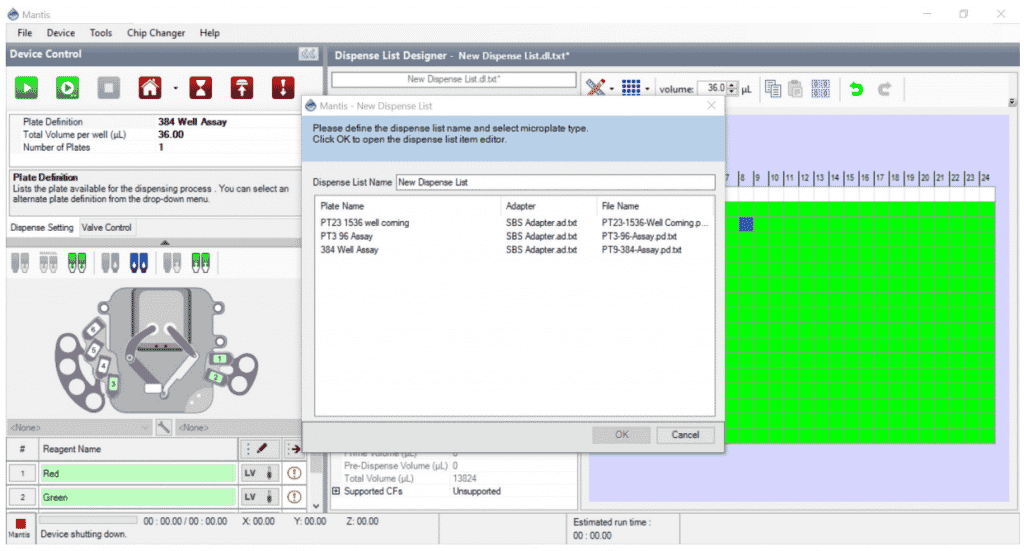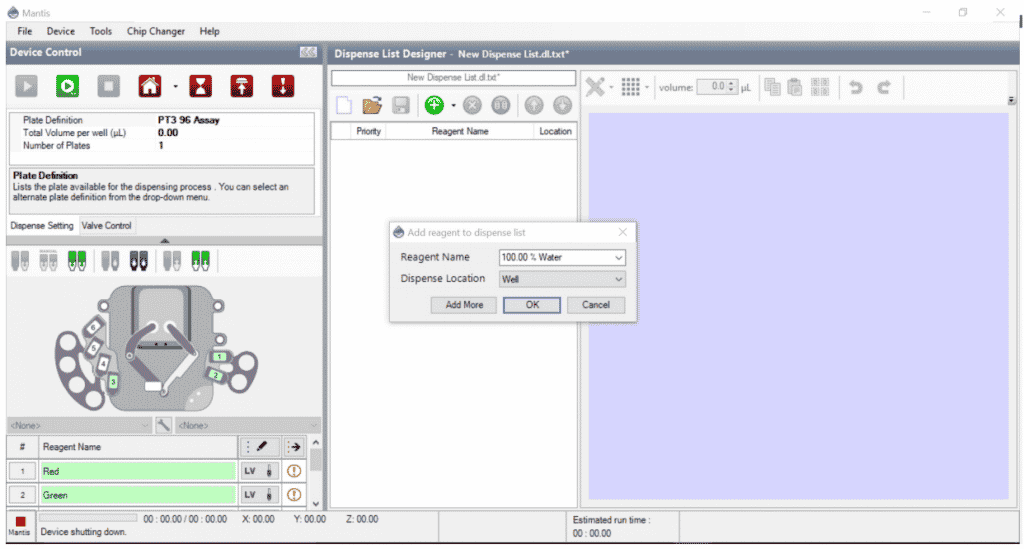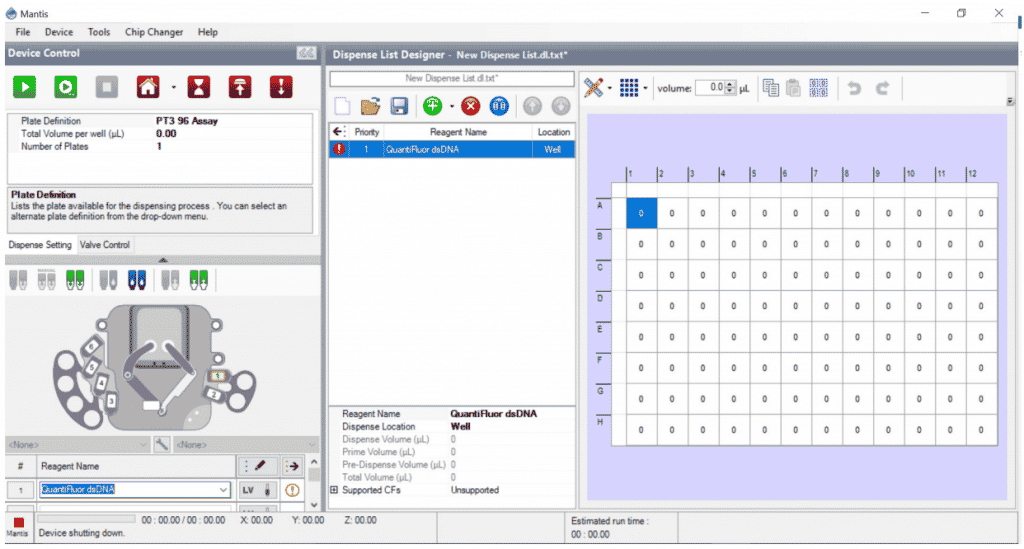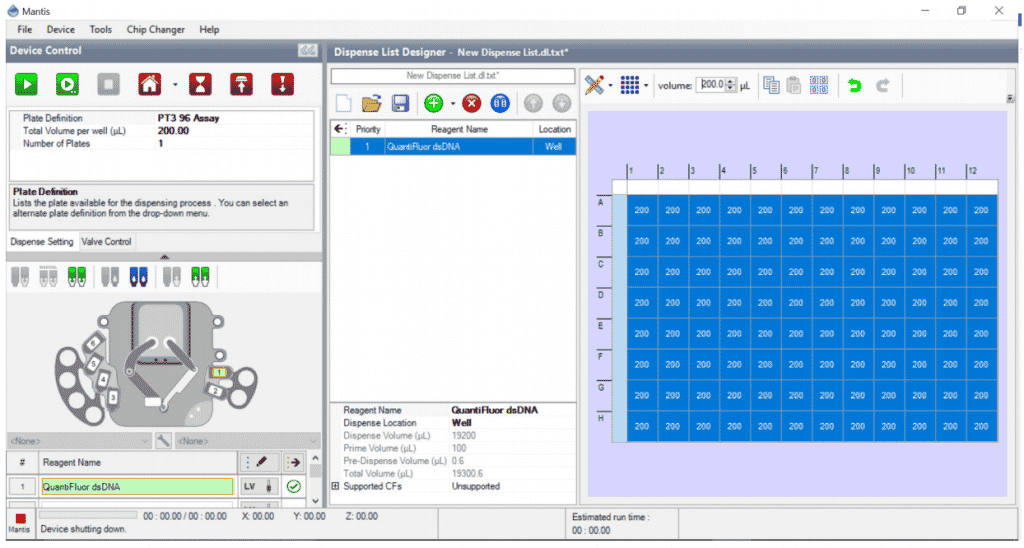Fast, accurate and flexible DNA quantification using the QuantiFluor® dsDNA System on the MANTIS® Liquid Processor
Introduction
Nucleic acid quantification is an important step in molecular biology workflows, especially for advanced applications such as qPCR and next-generation sequencing (NGS). In NGS, the ultimate goal is to generate highly complex libraries and sequence them with maximum depth and homogeneity, so accurate quantification is particularly important. Two key steps to accurately determine nucleic acid concentration are:
- Maximum enzyme efficiency is sensitive to the amount of DNA input prior to library preparation and 2) after library preparation to standardize samples for pooling prior to sequencing. In addition, the need for increasingly smaller sample inputs (e.g., for RNA-seq experiments) and the challenge of isolating nucleic acids from many common sample types (e.g., FFPE and ccfDNA) make concentration estimation difficult.
While multiple quantification methods exist, fluorescent dye-based systems are recommended for advanced downstream applications due to their sensitivity, target selectivity, cost, and ease of use. With the QuantiFluor® dsDNA System, a stock solution of fluorescent dye is diluted to form a working solution, which is added to a microtiter plate containing a small volume of purified DNA sample, and fluorescence is measured using a fluorometer. The sensitive and accurate QuantiFluor® dsDNA System can be used to quantify dsDNA in single tubes as well as 96- and 384-well plates.
Ensuring accuracy during repetitive pipetting of small volumes can be difficult and the process is labor intensive, with errors and costly rework. As a result, most laboratories requiring higher throughput are opting for automated robotic liquid handling platforms for quantitative analysis. the MANTIS® is a new benchtop liquid handler that meets many of the requirements for high-throughput reagent dispensing at a fraction of the cost of larger systems. For nucleic acid quantitation, the MANTIS® accurately dispenses small volumes of QuantiFluor® dye working solution for reproducible quantitation results. In this application note, we demonstrate the compatibility of the MANTIS® Liquid Processor to quickly and accurately automate reagent processing for QuantiFluor® dsDNA systems in both 96-well and 384-well plate formats.
Required materials
- MANTIS® Instrument (Formulatrix)
- High Capacity Chip (Formulatrix Cat.# MCHS6)
- QuantiFluor® dsDNA System (Cat.# E2670)
- Nuclease-free water (Cat.# P1195)
- Black flat-bottomed 96-well plate (Corning Cat.# 3915) or 384-well plate (Corning Cat.# 3573)
- 15ml or 50ml conical tubes
- Multi-well detector for fluorescence measurement (e.g., GloMax Discover System [Cat.# GM3000])
Experimental program
Reagent Preparation.
Prepare 1X TE Buffer: Dilute 20X TE Buffer 20 times with nuclease-free water.
Prepare a working solution of QuantiFluor® dsDNA dye.
a. 96-well format: Dilute QuantiFluor® dsDNA dye 1:400 in 1X TE buffer. Refer to QuantiFluor® dsDNA System Technical Manual #TM346 for detailed instructions on use.
b. 384-well format: Dye dilutions are based on your desired analytical requirements. (See Application Note for High-Throughput, Low-Volume DNA Quantification with the QuantiFluor® dsDNA System for information on how to select the appropriate dye dilution. ) Here we use a 1:200 dilution of QuantiFluor® dsDNA dye in 1X TE buffer to quantify 0.05-50ng DNA.
Preparation of Standard Curve: Serial dilutions were made using a known concentration of dsDNA standard and 1X TE buffer that extends up and down the concentration range of any unknown samples. For blank samples, use 1X TE Buffer.
Instrument settings.
Open the MANTIS® desktop application and select File > New Distribution List. Select your determination plate from the list.

The software will prompt the user to add the reagent to the distribution list. Enter "QuantiFluor dsDNA" in the "Reagent Name" field and select "OK" when finished.

Assign QuantiFluor dsDNA to microarray position #1

Place the QuantiFluor® dsDNA Working Solution in the reagent rack at microarray position #1. Place the tube from the chip into the reagent.
Fill the chip and set up a new liquid dispense by selecting the desired hole and entering the target volume for the selected hole
a. 96-well format: Dispense 200 µl of working solution into each well.
b. 384-well format: dispense 36 µl of working solution into each well.

Add the microplate to the MANTIS®deck and press Start.
Analytical Determination:
Manually pipette standards, blanks and unknown samples into their respective wells of the multiwell plate.
c. 96-well format: add 1-20 µl of standards, blanks, and unknown samples.
d. 384-well format: add 4µl of standard, blank and unknown.
Mix the microplate thoroughly by pipetting the liquid in each well using a plate shaker or by pipetting. Failure to mix thoroughly will result in variations in readings between wells. Also avoid introducing air bubbles, which can interfere with fluorescence.
Incubate the assay for 5 minutes at room temperature.
Detects fluorescence (504nmEx/531nmEm). If using a GloMax® Systems detection instrument, select the preloaded protocol: "QuantiFluor dsDNA System".
Calculate the dsDNA concentration as follows: remove the fluorescence of the blank sample (1X TE buffer) from each standard and sample fluorescence. Generate a standard curve of fluorescence versus DNA concentration using calibration data from the DNA standards. Determine the DNA concentration of any unknown samples in the standard curve by linear or power regression.
Standardization.
- Concentration values from the GloMax® detection instrument can be imported directly into the MANTIS® software to calculate the volume required for standardization (see Figures 1 and 2).

Figure 1. Quantification of the K562 Human Genomic DNA Standard (Cat.# E4931) using the MANTIS® Liquid Processor to dispense QuantiFluor® dsDNA Dye working solutions in 96-well plates (Figure A) and 384-well plates (Figure B). Fluorescence was measured on the GloMax® Discover System and unknown samples were inserted from within the power regression standard curve.

Figure 2. Quantification of the 2,200bp PCR product used to model the average size of mRNA transcripts. The Mantis Liquid Processor was used to dispense the QuantiFluor® dsDNA System in 96-well plate format (Figure A) and 384-well plate format (Figure B). Fluorescence was measured on the GloMax® Discover System and unknown samples were inserted from within the power regression standard curve.
Summary
The MANTIS® Liquid Processor provides researchers with a flexible workstation to build a variety of experimental protocols in minutes. Execute these protocols precisely to improve laboratory efficiency and experimental reproducibility. This application note demonstrates the ease of use of liquid handling software, which allows for a quick and seamless transition to an automated platform. Using the MANTIS® Liquid Handler to add reagents to the QuantiFluor® dsDNA System enables reproducible quantitation in multilayer microtiter plates with little to no instrument programming.
Source: @BostonFummerle
Time: 2022.02.15
Related Products
Formulatrix Mantis Microplate Dispenser
Formulatrix USA upgrades micro automated dispensing*




